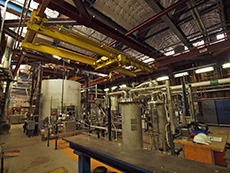Liquid-Argon Purity Demonstrator cleans up well
 |
A large holding tank and network of filters make up the Liquid-Argon Purity Demonstrator. Photo: Terry Tope, PPD |
It's been 15 months since the Liquid-Argon Purity Demonstrator filtered its first batch of liquid argon, showing for the first time that to purify it, you don't have to throw it out with the proverbial bathwater.
The demonstrator, a 30-ton tank of liquid argon connected to a purifying filter system, tests whether it's possible to remove electronegative contaminants such as water and oxygen from the liquid without having to evacuate the vessel before filling it with argon, as previous experiments have done.
Recently, the LAPD team was able to do just this, successfully purifying liquid argon at the tank's full capacity without having to first evacuate the vessel. The results are very important to a number of neutrino experiments at Fermilab: Constructing a system similar to the demonstrator means that experiments using liquid argon can forgo the often expensive task of building evacuable vessels.
One of the demonstrator's challenges is to purify liquid argon to the levels needed for experiments such as MicroBooNE and LBNE. In such experiments, neutrinos strike liquid argon nuclei, producing particles that then ionize the argon atoms. The resulting electrons drift to wire detectors, also located in the tank.
Ultra-pure argon is important for being able to detect the ionization electrons created when charged particles travel through the liquid. This is because electronegative impurities such as water and oxygen could "gobble up" the electrons, never allowing them to travel the full distance to the readout wires, which can be over 2 meters from the point of ionization, said Fermilab physicist Brian Rebel, who leads the LAPD effort.
The demonstrator’s tank is first purged with argon gas, which acts like a piston to force the atmosphere out of the tank and reduce initial contamination levels. It then circulates through the filter network. After a full cycle, the argon ends up back in the tank to start the process over.
“This is an ultra-high-purity system, but there are a lot of steps to get to that state,” said Terry Tope, lead engineer for the demonstrator design.
For the first time, the demonstrator is filtering a full load of liquid argon, Rebel said. The 30-ton tank previously contained only one-third its full capacity.
Now scientists and engineers have mastered the purification of large volumes of liquid argon and can reduce electronegative contaminants down to a concentration of about 75 parts per trillion, which is low enough to ensure a strong signal, even if the electrons have to travel more than 2 meters before detection.
Additionally, a time projection chamber, used to detect the ionization electrons, now resides in the tank. The LAPD team has recorded clear images of a cosmic ray muon's path through the argon.
Read more
—Sarah Khan
|